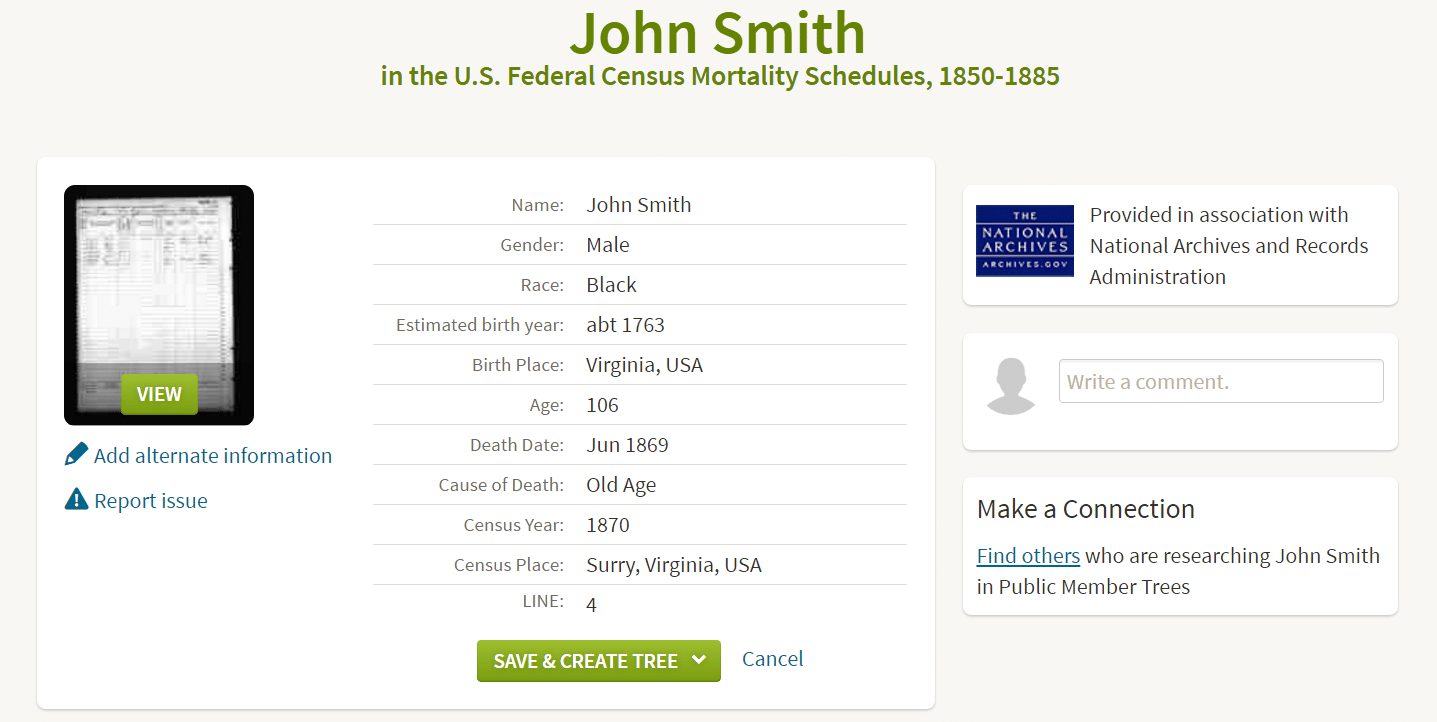Are you in search of a date or place of death for a certain member of your family tree, but keep coming up empty handed? If the individual passed away in the mid to late 1800s, U.S. Mortality Schedules – conducted in connection with the federal census – may be the key to finding the missing piece of your genealogy puzzle.
An index of these information-packed documents is now available to view for free on Ancestry. It will be necessary to purchase a paid subscription in order to view actual images of the original documents, but much of the information contained in the mortality schedules has been placed in the free, searchable index.
Some of these important records can also be accessed for free on various state websites. You can view our list of free archives by state here.
What are the U.S. Mortality Schedules?
Never heard of a mortality schedule? Simply put, they are a collection of names of those who died in the year prior to the census being conducted. Done alongside the federal population schedules, these documents contain the names of individuals who passed away between June 1st of the year before the federal census and May 31st of the census year.
While these important records were collected alongside the federal census, mortality schedules are an entirely separate collection. These national death registers were done in order to compile statistics on, and gain an understanding of, the rate of death for certain populations based on age, sex, nationality, occupation and other factors.
These schedules were only compiled federally for a limited number of US censuses, including the years of 1850, 1860, 1870 and 1880.
They were also conducted in six states as part of the often forgotten 1885 census, including Nebraska, Florida, Colorado, New Mexico, North Dakota and South Dakota. Unfortunately, some of the 1885 schedules no longer exist or are not included in Ancestry’s database – but they do offer the 1885 records for Colorado, Florida and Nebraska.
Despite the limited number of years that mortality schedules were compiled, for those individuals who were recorded on these documents there is a wealth of information to be found. And since these records predate vital records in many locations, they provide an invaluable tool for family history researchers.
The average mortality schedule includes the deceased person’s name, estimated birth year, birth place, age, death date, cause of death and more. These details are all found in the free index, which may also contain additional information – like facts about the individual’s parents. More information can be found on the original document in most cases (if you have a paid Ancestry account).
An Index Entry for a 1870 Mortality Schedule:
While the information contained in these records is much the same as you might find on an ancestor’s death certificate, it should not be relied on to have the same level of accuracy. Why? The information collected on mortality schedules, like that of any census, is dependent on the care of the enumerator as well as the accuracy of the person providing the information at the time.
Enumerators did not verify the information they were given on persons living in the home, including name spellings, ages or occupations. This is also true with information on someone’s death – which could be incorrectly reported by a member of the household who was confused or misinformed, or simply in a hurry.
This is why it’s very important to remember that census information must always be considered cautiously and backed up by other, more accurate, sources. If you do find your ancestor in one of these records use the details as a jumping off point to try and discover other sources of death information – such as those in this article.
Think information about one of your ancestors may be listed on one of the mortality schedules?
You can dig deeper into these records by accessing the free, searchable index of US mortality schedules on Ancestry right here. This collection is just one of over 800 that Ancestry offers for free. You can learn more about that here.
Note: FamilySearch also offers the images of the 1850 mortality schedules at no-cost right here, but do not currently offer other years.
Looking for facts on a Canadian ancestor? You can find Canadian mortality schedules for the year 1871 here. The free searchable index includes images and encompasses individuals who passed away in the 12 months prior to April 1871, in the provinces of Nova Scotia, New Brunswick, Quebec and Ontario.
Also read: How to Search for Free Obituaries Online
By Kate Jackson, Associate Editor, Family History Daily
Unofficial Ancestry.com Crash Course
Family History Daily now offers an unofficial online Ancestry.com Crash Course to help you uncover more records on this popular genealogy research site. Whether you’re just starting your research, or have been at it for years, you’ll learn many new tricks and techniques to help you discover your ancestors and build your tree. Register here.
Image: “U.S. census expert finds out ages of persons whose births have not been registered.” Washington, D.C., Nov. 27, 1937. Library of Congress.



In response to Stan Arney’s comment of September 5, 2017 at 8:16 AM
I have to disagree with this comment that “Searches” are USELESS, IF you must PAY, for the privilege to view and download!”
In my opinion, it is very useful to find an indexed record on any website, as it gives you a clue to what you are looking for and where to find it. Just because one website, such as Ancestry.com may have a record you have to pay to see; there very well be another website that has it for free; all you need to do is search for the record on Google.
“Searching” an Index on Ancestry.com is one thing, being able to view the image, let alone, download a copy of the image, is quite another. In my opinion, “Searches” are USELESS, IF you must PAY, for the privilege to view and download!
Infelizmente no momento não tenho condições financeiras de colaborar com o site porém o registro da árvore genealógica eu fiz mas gostaria de aprofundar mais minhas pesquisas pis é ótimo para buscas e quando tiver condições irei colabora financeiramente.Peço por favor a caridade de me aceitarem.
Agradeço do fundo do coração.
Ps infelizmente não falo inglês pode ser em português.